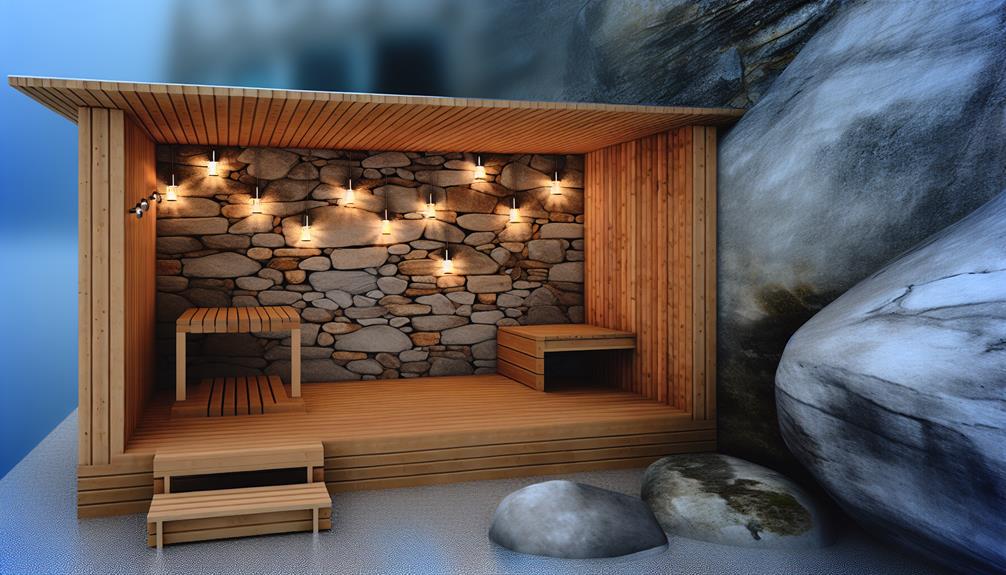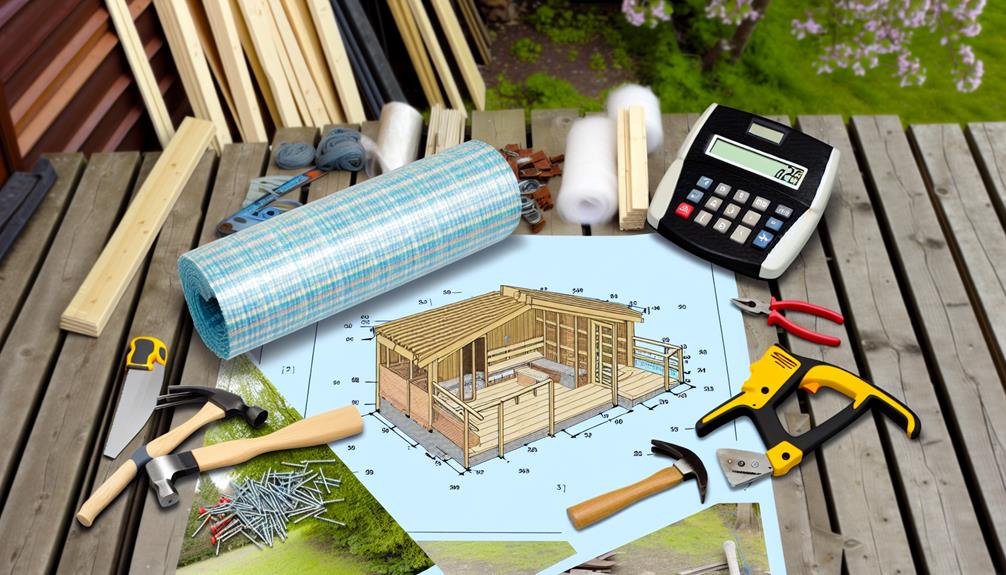Imagine building an outdoor sauna like assembling a puzzle; each piece contributes to the whole experience. Picture the warmth enveloping you, the scent of cedar lingering in the air – a retreat in your backyard.
Now, as you embark on this project, you'll need careful planning and attention to detail. But, before you rush off to gather materials, there's a crucial first step that sets the foundation for your soothing oasis.
Key Takeaways
- Select a level ground area with proper ventilation and space for stability and comfort.
- Use moisture-resistant materials like cedar, aluminum foil vapor barriers, and locally sourced cedar shingles.
- Incorporate design elements such as windows, benches, air vents, and a sauna door for functionality and aesthetics.
- Choose an appropriate heat source like electric heaters, infrared heaters, or wood-burning stoves based on preferences and sauna size.
Location and Size Selection
When selecting a location for your outdoor sauna, ensure you have a level ground area with a minimum space of 7ft high and 6ft wide for the sauna box. This will provide a stable foundation for your sauna construction. The location should also allow for proper ventilation to ensure a comfortable sauna experience. Adequate ventilation is crucial for maintaining air quality within the sauna and preventing overheating. Additionally, consider the heat circulation within the outdoor sauna to ensure even distribution of warmth.
When determining the size of your outdoor sauna, factors such as the number of occupants and available space should be taken into account. Sauna size can range from 4ft by 6ft for 2-3 people to larger options based on social needs and safety considerations. It's important to strike a balance between having enough space for relaxation and ensuring efficient heat circulation throughout the sauna. By carefully selecting the location and size of your outdoor sauna, you can create a comfortable and enjoyable environment for your sauna sessions.
Materials Selection
To ensure optimal durability and performance of your outdoor sauna, carefully select moisture-resistant materials like cedar or beetle kill pine to withstand the high humidity levels typically experienced in sauna environments. Consider using recycled cedar lumber for an eco-friendly and sustainable option.
Opt for aluminum foil vapor barriers to ensure proper heat retention and insulation in the sauna walls and ceiling. Choose locally sourced cedar shingles for the sauna roof to enhance sustainability and aesthetics.
When building your sauna, prioritize energy-efficient options such as infrared heaters or eco-friendly wood-burning stoves. Insulating the walls effectively and selecting the right heat source are crucial steps in creating a comfortable sauna experience.
Design Elements Addition

Consider incorporating windows for natural light and ventilation to enhance the design of your outdoor sauna. Windows not only brighten the space but also allow for air circulation, creating a more comfortable environment. Efficient heat circulation is crucial for a sauna, achieved through well-placed air vents near the ceiling and floor to evenly distribute the heat. Ample seating is essential for relaxation; include benches along the walls or in a corner configuration to accommodate varying preferences. Proper ventilation is key to prevent the sauna from becoming too hot and humid. Enhance ventilation by placing a vent near the heater to allow for air exchange. Design elements such as a carefully positioned sauna door and selecting appropriate materials contribute to both functionality and aesthetics. When building your own outdoor sauna, these design elements play a significant role in creating a space that is inviting and enjoyable.
| Design Elements | Description |
|---|---|
| Windows | Allow natural light and ventilation |
| Benches | Provide seating for relaxation |
| Air Vents | Ensure efficient heat circulation |
| Sauna Door | Key element for accessibility |
Heat Source Choice
For an authentic sauna experience with a traditional aroma, wood-burning stoves are a recommended choice as the heat source. Wood-burning stoves not only create a cozy ambiance but also provide that classic sauna scent. However, it's crucial to ensure proper ventilation when using wood-burning stoves to maintain safety within the sauna environment.
Consider the following when choosing a heat source for your outdoor sauna:
- Electric Heaters: Offer convenient temperature control and easy installation.
- Infrared Heaters: Provide gentle heat for therapeutic benefits and energy efficiency.
- Wood-Burning Stoves: Create a traditional sauna experience and aroma but require adequate ventilation.
- Consideration Factors: Choose a heat source based on personal preferences, sauna size, and the desired sauna experience.
Selecting the right heat source is pivotal in achieving an optimal sauna experience tailored to your preferences and needs. Consider factors such as energy efficiency, therapeutic benefits, and temperature control to make an informed decision.
Total Cost Estimation

How much can you expect to spend on building an outdoor sauna, considering various factors such as size, materials, and desired amenities?
The total cost for constructing an outdoor sauna can vary significantly. Opting for a DIY sauna using basic sauna kits typically ranges between $3,000 to $6,000. If you prefer a more customized outdoor sauna, the investment may increase, but you can enjoy personalized features tailored to your preferences.
Total costs for building outdoor saunas can start as low as $2,000 if you repurpose materials, while using store-bought materials might raise the budget to around $10,000. Factors influencing the total cost include the size of the sauna, the type of materials chosen, the heat source utilized, and any additional amenities incorporated.
Making energy-efficient choices and selecting eco-friendly options can also impact the overall expenditure of your custom outdoor sauna, ensuring a worthwhile investment in your health and well-being.
Frequently Asked Questions
How Much Does It Cost to Build an Outdoor Sauna?
To build an outdoor sauna, you require a budget breakdown including materials, labor, and hidden costs. Consider DIY vs. professional options, pricing factors like size and location, and plan for insulation, heat source, seating, and ventilation.
Can I Build My Own Outdoor Sauna?
You can definitely build your own outdoor sauna! With DIY kits or custom designs, you control the process. Consider budget, safety, design, maintenance, and location. Remember, "Rome wasn't built in a day"—take your time and enjoy the journey.
Is It Worth Getting an Outdoor Sauna?
Getting an outdoor sauna is worth it for health benefits, relaxation, and socializing. Minimal maintenance, easy installation, energy-efficient options, various designs, location flexibility, safety measures, and customization make it a valuable investment for property and well-being.
How Long Does It Take to Build an Outdoor Sauna?
When building an outdoor sauna, construction timeline varies based on complexity. Basic kits take around 20 hours. Custom designs need more time. Material choices, weather considerations, and DIY options impact the installation process. Regular maintenance ensures energy efficiency.
Conclusion
In conclusion, building an outdoor sauna is like crafting a sanctuary in your backyard, where relaxation and rejuvenation await.
By carefully selecting the location, materials, design elements, and heat source, you can create a haven for unwinding and detoxifying.
Remember, like tending to a delicate flame, proper maintenance and attention to detail will ensure your outdoor sauna stands the test of time, providing warmth and comfort for years to come.

Leave a Reply